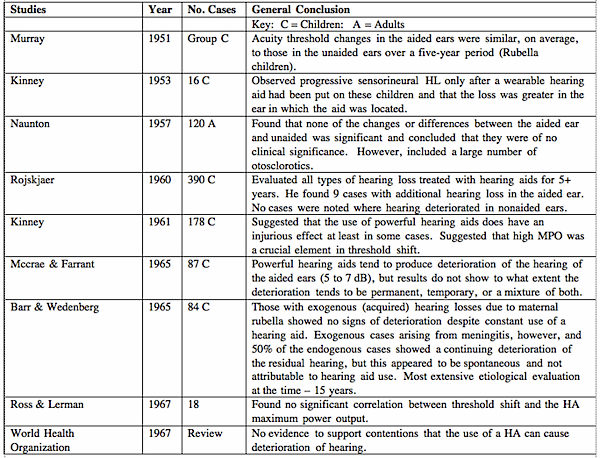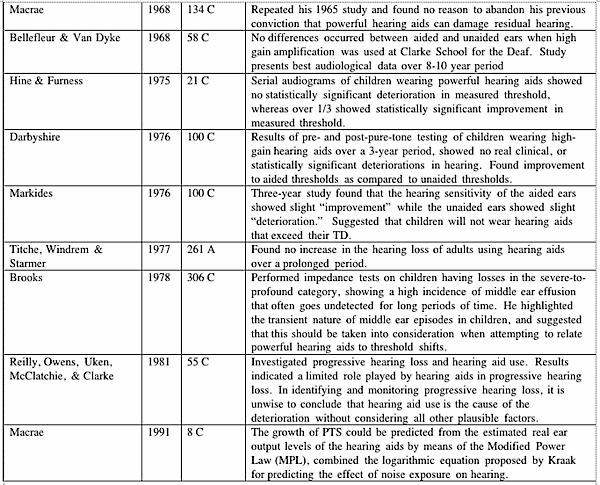Do Hearing Aids Cause Further Hearing Loss?
The past couple of weeks the topic of whether hearing aids cause further hearing loss has been presented. Last week’s post on this topic reviewed some of the case studies that have been published on this subject. Although of significant interest, most are single case studies and often fall into the category of being anecdotal reports because the conditions leading to the event often are sketchy. The underlying issue, as discussed previously, involves the relationship of TTS (Temporary Threshold Shift) to PTT (Permanent Threshold Shift). This post reviews some of the results from controlled studies involving larger groups of subjects. Subsequent posts will discuss the results.
Summary of Studies of Larger Groups of Hearing Impaired and Results of Wearing Hearing Aids
Barr, B, & Wedenberg, E. Prognosis of perceptive hearing loss in children with respect to genesis and use of hearing aid. Acta Otolaryngol. 59, 1965, pp. 462-474.
Bellefleur, P.A., and Van Dyke, R.C. The effects of high gain amplification on children in a residential school for the deaf. J. Sp. And Hear. Res. 11, 1968, pp. 343-347.
Brooks, D.N. Acoustic impedance testing for screening auditory function in schoolchildren, Part II. Maico Audiological Library Series, V. XV, Report 9, 1978.
Darbyshire, J.O. A study of the use of high-power hearing aids by children with marked degrtees of deafness and the possibility of deteriorations in auditory acuity, British Journal of Audiology, Vol. 10, 1976, pp. 74-82.
Hine, W.D. & Furness, H.J.S. Does wearing a hearing aid damage residual hearing? The Teacher of the Deaf, 1975, 73, pp. 261-267.
Kinney, C.E. Hearing impairments in children. Laryngoscope, 1953, 63, pp. 220-226.
Kinney, C.E. The further destruction of partially deafened children’s hearing by the use of powerful hearing aids. Ann. Otol. Rhinol. Laryngol., 70, 1961, pp. 828-835.
Macrae, J.H. Recovery from tts in children with sensorineural deafness. Journal of the Acoustical Society of America, 44, 1968, 1451.
Macrae, J.H. Permanent threshold shift associated with overamplification by hearing aids, J. Sp & Hear Res., 1991, vol. 34, pp. 403-414.
Macrae, J.H. and Farrant, R.H. The effet of hearing aid use on the residual hearing or children with sensorineural deafness. Ann. Otol. Rhinol. Laryngol., June, 1965, 74(2), 409-419.
Markides, A. The effect of hearing aid use on the user’s residual hearing. Scan. Audiol. 5, 1976, pp. 205-210.
Murray, N.E. Hearing aids and classification of deaf children. Report, C.A.L.-1R-2. Commonwealth Acoustic Laboratories, Sydney, 1951.
Naunton, R.F. The effect of hearing aid use upon the user’s residual hearing. Laryngoscope, 67, 1957, pp. 569-576.
Reilly, K.M., Owens, E., Uken, D., McClatchie, A.C., and Clarke, R. Progressive hearing loss in children: hearing aids and other factors. J. Sp. & Hear. Dis., August 1981, pp. 328-334.
Rojskjaer, C. Presented at the Fifth International Congress of Audiology, Bonn, 1960.
Ross, M. & Lerman, J. Hearing aid usage and its effect upon residual hearing. Archives of Otology, 86, 1967, pp. 639-644.
Titche, L.L., Windrem, E.O., & Starmer, W.T. Hearing aids and hearing deterioration. Annals of Otology, 86, 1977, pp. 357-361.
World Health Organization. The early detection and treatment of handicapping defects in young children. Report on a Working Group Convened by the Regional Office for Europe of the World Health Organization, 1967.
Next Week’s Post will attempt to analyze the results of these studies, what might have been done in the interim to circumvent some of the issues, and how TTS might relate to PTS, at least for hearing aid use.







